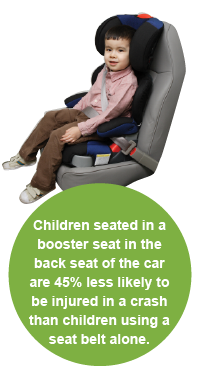 Kids who have outgrown their car seats are not quite ready for a seat belt alone – although they might try to convince you otherwise. Instead, have them transition to a booster seat that enables the adult seat belt to fit properly. Booster seats can actually be pretty cool. Here are a few tips to make sure your kids are safe in a booster seat.
Kids who have outgrown their car seats are not quite ready for a seat belt alone – although they might try to convince you otherwise. Instead, have them transition to a booster seat that enables the adult seat belt to fit properly. Booster seats can actually be pretty cool. Here are a few tips to make sure your kids are safe in a booster seat.
Hard Facts
Children seated in a booster seat in the back seat of the car are 45% less likely to be injured in a crash than children using a seat belt alone.
Top Tips
- When your child is seated in the booster seat, make sure the lap and shoulder belts fit correctly. The lap belt should fit low across the hips and the shoulder belt across the shoulder.
- Do not place the shoulder belt under the child’s arm or behind the child’s back.
- Older kids get weighed and measured less often than babies, so check your child’s growth a few times a year. Generally, kids need to use a booster until they are at least 4 feet 9 inches tall and weigh between 80 and 100 pounds. For most kids, they will be between ages 8 to 12 years old.
- Talk with everyone who drives your kids so they understand that booster seat use is a must when your child is in their vehicles.
- Use a booster seat with the vehicle lap AND shoulder safety belts until your child passes the following Safety Belt Fit Test:
- The child’s knees should bend at the edge of the seat when his or her back and bottom are against the vehicle seat back; and
- The vehicle lap belt should fit across the upper thighs or low on the hips; and
- The shoulder belt should fit across the shoulder and chest. Children are usually between 8 and 12 years old when the seat belt fits them properly.
Learn More
Learn more about other areas of safety in and around cars, including car seat safety and seat belt safety, how to protect your kids from heatstroke in cars, driveway safety, how to avoid getting trapped in the trunk; and how to prepare teens and preteens for driving before they get behind the wheel.
